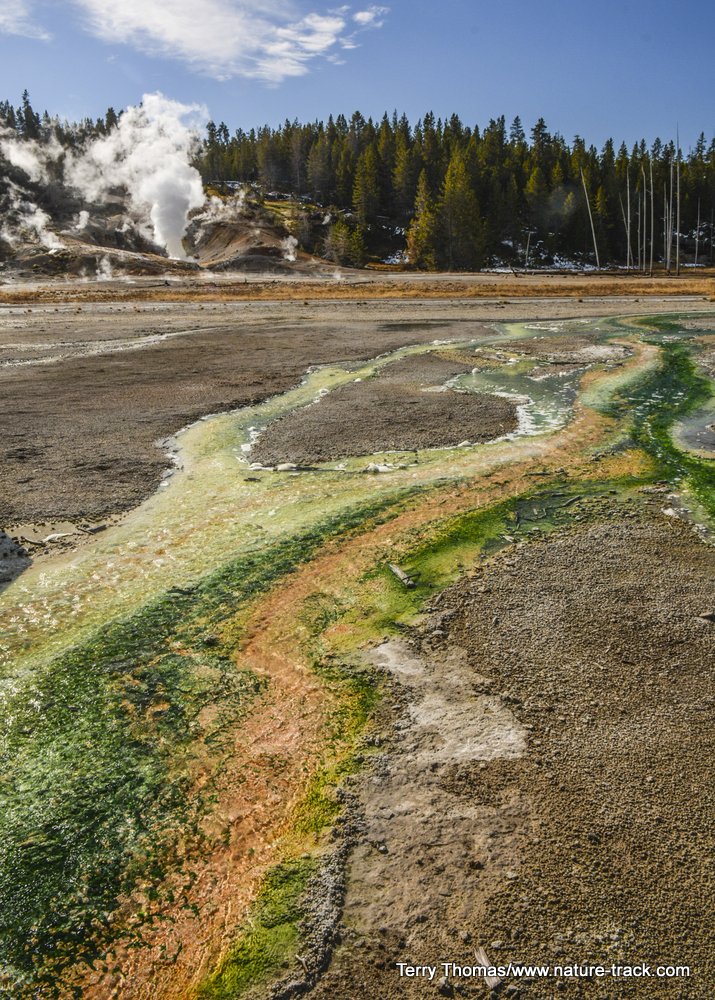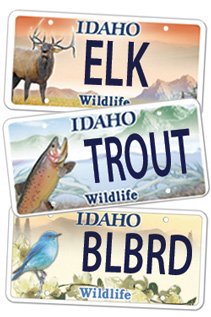Extremophiles

This extremely hot water in Norris Geyser Basin in Yellowstone National Park shows bands of heat-loving algaes and bacteria in the colorful bands on the bottom.
In the 1960’s, researchers believed that the limit of tolerance for heat-loving bacteria hovered around 131 degrees Fahrenheit (humans risk 3rd degree burns if exposed to water heated to 140 degrees Fahrenheit for two seconds). Fifty years ago, in 1969, scientists from Indiana University shocked the scientific world by discovering a bacteria which they named, Thermus aquaticus, in Mushroom Spring of Lower Geyser Basin in Yellowstone National Park that thrived at temperatures of 158 degrees Fahrenheit and could function up to 20 degrees hotter.
Thermus aquaticus further stunned the world by providing a heat-resistant enzyme, Taq DNA polymerase, which has become one of the most important enzymes in molecular biology because of its role in the polymerase chain reaction. This is a method of DNA amplification used replicate pieces of DNA for study (think DNA testing for criminal forensics and genome sequencing).
Since then, the study of extremophiles, organisms that live and/or thrive in extreme conditions, has become a mainstream science and the discoveries are nothing short of fantastic.
There are two broad categories of extremophiles. First, there are those that can tolerate extremes in the environment but grow optimally in more normal environmental conditions. Second, are organisms that actually require extreme conditions to thrive. Thermus aquaticus is one of the latter, requiring temperatures between 120- and 170-degrees Fahrenheit for survival. To them, these aren’t extremes.
Besides heat, scientists have found organisms surviving or thriving under almost every imaginable extreme that we normally consider completely unlivable. They are often classified according to the extreme condition that they tolerate or require, using the suffix, “phile”, which means, “loving”. For instance, acidophiles are acid loving. There are alkaliphiles (alkaline-loving), barophiles (living under extreme pressure like at the bottom of the ocean), halophiles (salt-loving), thermo and hyperthermophiles (heat-loving. The highest heat tolerance found to date is 252 degrees Fahrenheit), psychrophiles (organisms that grow best at low temperatures) and even radophiles, organisms that can stand up to 3,000 times the amount of radiation that would kill a human. Even more, many extremophiles are considered polyextremophiles, meaning that they can handle extremes in more than one area, for instance, heat and acid.
As the science progresses, researchers are finding that there are few places that some extremophile isn’t living, including in industrial solvents, and where they can survive by eating chemicals or minerals in processes reminiscent of photosynthesis.
Extremophiles include members of the three domains of life: archaea, bacteria and eukarya. There are some that are multi-cellular and even somewhat complex such as protozoa, algae, fungi, brine shrimp and tube worms. However, the vast majority are microorganisms, and most of those are archaea, the simplest forms of life.
This area of science continues to grow and attract some of the best minds because of the potential for discovery of systems humans can use to further our own future. For instance, researchers hope to one day unlock the secrets to radophiles and develop an “anti-radiation” pill for humans.
In addition, this knowledge is changing the way we look at life. Scientists are asking new questions and challenging just what, exactly, are the fundamental features of life. Have we been too narrowly defining life?
Finally, extremophiles give breath to the challenge of finding life on other planets within our solar system. If these creatures can survive in the depths of the ocean, in volcano vents, in blocks of sea ice, and deep underground on Earth, perhaps there are extremophiles on Mars too. They will likely take the form of single-celled organisms though, not little green men.
Wildlife License Plates
Great news! as of 2024, there are three NEW designs for license plates. They still are bluebird, cutthroat trout and elk, but they are beautiful.
Idaho Wildlife license plates provide essential funding that benefits the great diversity of native plants and wildlife that are not hunted, fished or trapped—over 10,000 species or 98% of Idaho’s species diversity. Game species that share the same habitats (such as elk, deer, antelope, sage-grouse, salmon, trout) also benefit from these specialty plates.
No state tax dollars are provided for wildlife diversity, conservation education and recreation programs. Neither are any revenues from the sale of hunting or fishing licenses spent on nongame species. Instead, these species depend on direct donations, federal grants, fundraising initiatives—and the Idaho Wildlife license plates.
Both my vehicles have Bluebird Plates. I prefer the bluebird because the nongame program gets 70 percent of the money from bluebird plates, but only 60 percent of the money from elk and trout plates - 10 percent of the money from elk plates supports wildlife disease monitoring and testing programs (to benefit the livestock industry) and 10 percent from cutthroat plates supports non-motorized boat access.
Incidentally, in 2014, the Idaho Legislature denied the Department of Fish and Game the ability to add new plates or even to change the name of the elk and cutthroat plates (very specific) to wildlife and fish plates, a move that would have allowed for changing images occasionally and generating more revenue. It would seem that they believe that we Idahoans don't want a well funded wildlife program.
I think it is time we let the Legislature know that Idahoan support wildlife funding and that we would like to see these generic plates come to fruition.
Help Idaho Wildlife
When we traveled across the state in October 2017, we visited most of the Idaho Department of Fish and Game wildlife management areas. Most of the vehicles we saw using the wildlife management areas did not have wildlife plates. Buying wildlife plates is a great way for non-hunters and hunters alike to support wildlife-based recreation like birding.
C'mon folks, let's help Idaho's wildlife by proudly buying and displaying a wildlife license plate on each of our vehicles!
See below for information on Idaho plates. Most states have wildlife plates so if you live outside Idaho, check with your state's wildlife department or vehicle licensing division for availability of state wildlife plates where you live.
And tell them that you heard about it from Nature-track.com!

Wildlife License Plates
Great news! as of 2024, there are three NEW designs for license plates. They still are bluebird, cutthroat trout and elk, but they are beautiful.
Idaho Wildlife license plates provide essential funding that benefits the great diversity of native plants and wildlife that are not hunted, fished or trapped—over 10,000 species or 98% of Idaho’s species diversity. Game species that share the same habitats (such as elk, deer, antelope, sage-grouse, salmon, trout) also benefit from these specialty plates.
No state tax dollars are provided for wildlife diversity, conservation education and recreation programs. Neither are any revenues from the sale of hunting or fishing licenses spent on nongame species. Instead, these species depend on direct donations, federal grants, fundraising initiatives—and the Idaho Wildlife license plates.
Both my vehicles have Bluebird Plates. I prefer the bluebird because the nongame program gets 70 percent of the money from bluebird plates, but only 60 percent of the money from elk and trout plates - 10 percent of the money from elk plates supports wildlife disease monitoring and testing programs (to benefit the livestock industry) and 10 percent from cutthroat plates supports non-motorized boat access.
Incidentally, in 2014, the Idaho Legislature denied the Department of Fish and Game the ability to add new plates or even to change the name of the elk and cutthroat plates (very specific) to wildlife and fish plates, a move that would have allowed for changing images occasionally and generating more revenue. It would seem that they believe that we Idahoans don't want a well funded wildlife program.
I think it is time we let the Legislature know that Idahoan support wildlife funding and that we would like to see these generic plates come to fruition.

"WOW. What a phenomenal piece you wrote. You are amazing." Jennifer Jackson
That is embarrassing, but actually a fairly typical response to my nature essays. Since The Best of Nature is created from the very best of 16 years of these nature essays published weekly in the Idaho Falls Post Register (online readership 70,000), it is a fine read. It covers a wide variety of topics including humorous glimpses of nature, philosophy, natural history, and conservation. Readers praise the style, breadth of subject matter and my ability to communicate complex and emotional topics in a relaxed and understandable manner.
Everyone can find something to love in this book. From teenagers to octogenarians, from the coffee shop to the school room, these nature essays are widely read and enjoyed.
Some of the essays here are my personal favorites, others seemed to strike a chord with readers. Most have an important message or lesson that will resonate with you. They are written with a goal to simultaneously entertain and educate about the wonderful workings of nature. Some will make you laugh out loud and others will bring a tear to the eye and warm your heart.
Readers Write:
"You hit a home run with your article on, Big Questions in Nature. It should be required reading for everyone who has lost touch with nature...great job!" Joe Chapman
"We enjoyed your column, Bloom Where Planted. Some of the best writing yet. The Post Register is fortunate to have your weekly columns." Lou Griffin.
To read more and to order a copy, click here or get the Kindle version
Copies are also available at:
Post Register
Island Park Builders Supply (upstairs)
Barnes and Noble in Idaho Falls
Harriman State Park, Island Park
Museum of Idaho
Valley Books, Jackson Wyoming
Avocet Corner Bookstore, Bear River National Wildlife Refuge, Brigham City, Utah
Craters of the Moon National Monument Bookstore, Arco, Idaho